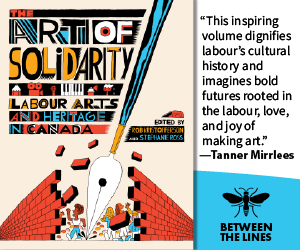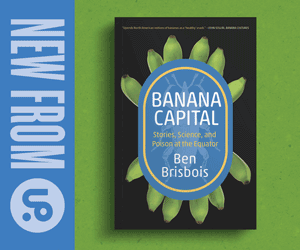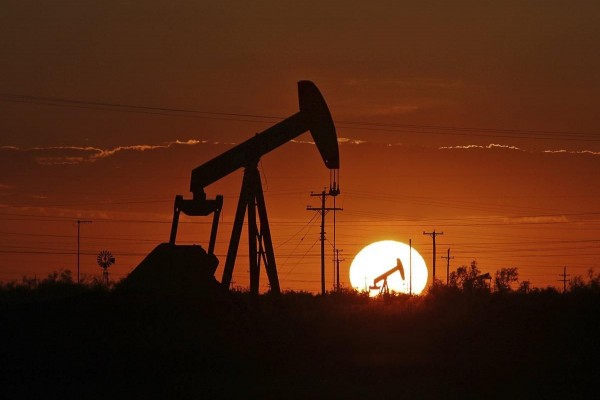The Day After: Water
The seventh installment in an ongoing series analyzing the perils and possibilities of our collective response to COVID-19

The Mackenzie Delta, pictured, spans 13,500 square kilometers and contains approximately 25,000 lakes. It includes the second largest drainage basin of any North American river after the Mississippi. Photo courtesy of Pat Kane/Gordon Foundation.
The Day After: Water marks the seventh installment in an ongoing curated series that asks contributors to imagine the perils and possibilities that will ground our collective response to or emergence from the COVID-19 crisis. The first installment was about animals, the second was about food, the third was about energy, the fourth was about infrastructure, the fifth was about extraction, and the sixth was about the Arctic.
This series asks Canada’s leading scholars to respond to questions of “human-environment” relations to consider our post-COVID future: What opportunities make you hopeful and what risks do you see at the “human-nature” interface? How can we build an ethic of care for socioecological systems?
These scholars of critical environmental studies have dedicated their professional lives to grappling with questions of environmental conflict, governance and justice—here, we have asked them to turn their reflections toward the public. Together, we hope this contributes to a broad and ongoing discussion on how the COVID-19 crisis can produce visions of the future of “human-environment relations,” for better or worse.
Our seventh edition, about water, features contributions from Heather Dorries, Alice Cohen, Brittany Luby and the Niisaachewan Anishinaabe Nation, Kathryn Furlong, and Deborah McGregor.
Heather Dorries is Anishinaabe from Winnipeg and an Assistant Professor in the Department of Geography and Planning and Centre for Indigenous Studies at the University of Toronto. Her research is focused on the relationship between urban planning and settler colonialism, as well as the application of Indigenous knowledge in planning contexts.
What are the practices and relations that will sustain us now and in the post-COVID world?
Plains Cree artist Ruth Cuthand explores the relation between colonialism, water, disease, and Indigenous survival in her artwork. In her work “Don’t Breathe Don’t Drink,” Cuthand creates beaded representations of water borne pathogens. Responding to the crises of contaminated water and decades-long boil water advisories on dozens of First Nations, this work highlights the impacts of colonialism on Indigenous peoples and waters and draws attention to the necessity of clean water to sustain health and life. Similarly, in her “Trading” series, she creates beaded representations of the diseases—including bubonic plague, measles, and smallpox—that Europeans brought to Indigenous communities. Recently, she has also beaded the COVID-19 virus, as yet another ailment which Indigenous peoples must endure.
Cuthand explains that beads are a metaphor for colonization. Glass beads were traded for more valuable furs. But beyond this metaphor, the intricate work of beading also points towards practices of resistance and regeneration. In the face of colonization, confronting ecological and colonial violence through beading can also be understood as a form of resistance. Beading is quiet and contemplative work. While it may be less visible than other forms of resistance, it draws attention to the need for radical systemic change in order to secure relations to land and water upon which life depends. Beadwork also points to the practices that might aid in regeneration. Métis scholar Sherry Farrell Racette explains that beadwork is a means of reactivating traditions and ancestral knowledge. Thus, Cuthand’s work is a reminder of the ethics of care required to sustain relations with human and more-than-human kin upon which we all depend for survival.
Ruth Cuthand, “Boil Water Advisory #3, 2016.” Glass beads, resin and found glassware, dimensions variable. Photo courtesy of dc3 Art Projects.
Alice Cohen is an Associate Professor in Environmental and Sustainability Studies at Acadia University. She has co-edited several books about water governance including Water without Borders?: Canada, the United States, and Shared Waters.
Talk of a ‘green recovery’ has been afoot for weeks, but is front and centre again after Chrystia Freeland’s swearing in as the new Minister of Finance in mid-August. In her words: “I think all Canadians understand that the restart of our economy needs to be green. It also needs to be equitable. It needs to be inclusive. And we need to focus very much on jobs and growth.” Who can argue with that? Her language points to the need to address crises at the confluence of COVID-19, record-low oil prices, and a fast-spiraling climate crisis. Yet her statement doesn’t immediately call to mind the question of water, which is surprising, given the centrality of water to the extraction of fossil fuels and, on the flip side, to the water-specific ways that the climate crisis will be felt: floods, droughts, and sea level rise. But it is water that offers one of the greatest channels for an equitable and inclusive green recovery. This is the case for two reasons.
The first reason is that any investment in water will almost certainly include long-overdue investment in water infrastructure. The Federation of Canadian Municipalities estimates that it would cost $50 billion to address poor and aging infrastructure in municipally-controlled water and wastewater facilities. That figure continues to rise as infrastructure is damaged by climate-driven phenomena like flooding, hurricanes, and storm surges. Addressing water infrastructure creates green jobs; it also can create more resilient water delivery and treatment systems to minimize the impacts of climate change, especially in vulnerable communities.
Participants in a community-based river monitoring program take a sample from a lake. Photo courtesy of North Saskatchewan Riverkeeper.
One organization taking the lead here is the Indigenous Guardians Program (IGP), whose goal is to “empower communities to manage ancestral lands according to traditional laws and values.” The 2017-18 federal budget included an investment of $25 million over five years in the IGP as a pilot model, and initial findings suggest that “for every $1 invested, approximately $2.5 of social, economic, cultural, and environmental value has been created for stakeholders.” Continued investment in a program that addresses water quality and begins to address the enormous environmental injustices on which Canada was founded makes economic and social sense.
Outside of the IGP, Community Based Water Monitoring (CBWM)—that is, community members going out and testing the bodies of water where they live, work, and play—has filled many of the gaps left by funding cuts to water monitoring programs. But these programs are supported by patchy funding lasting on average just one to three years, leading to data gaps and overlaps, and significant time spent on grant-writing rather than monitoring. Despite these challenges, CBWM is a thriving and growing component of the water governance landscape, and is central to support in any green recovery.
Indeed, any green recovery efforts need to recognize and support the ongoing stewardship of such a critical resource.
Brittany Luby (atik totem) is an Assistant Professor of History at the University of Guelph who specializes in Crown-Indigenous relations in what is now known as northwestern Ontario. She is author of the forthcoming book Dammed: The Politics of Loss and Survival in Anishinaabe Territory.
Niisaachewan Anishinaabe Nation (NAN) is an Anishinaabe community located along the Winnipeg River. NAN exercises its inherent right to protect ancestral lands and waters for future generations, to practice its cultural traditions, and to exercise self-governance to ensure the wellbeing of all our relations.
For years, the International Joint Commission (IJC) and Lake of the Woods Control Board (LWCB), two federally financed organizations responsible for regulating water levels on Lake of the Woods, defined First Nations as a “Specific Interest Group.” Canada categorized First Nations like cottagers’ associations: groups with an interest in water levels. This label disregarded Aboriginal Title generally. It also ignored the English written version of Treaty 3 as published by Canada in which watersheds and waterways provide boundary lines and the arrival of settlers to share the land is contemplated. It was not until the 1980s that Canada, Ontario, and Manitoba sought an alternative position (and label) for First Nations as an “affirmation of Aboriginal and Treaty Rights in the Canadian Constitution (1982, section 35).”
Freed of the “Specific Interest Group” label, First Nations were invited to consult with colonial regulators about water levels. This was (and is) an imperfect solution. Consultation does not challenge the power dynamics coded into the Boundary Waters Treaty of 1909. With this treaty, Canada and the United States decided how to manage international boundary water issues. They laid out the structure and mandate of the IJC. They affirmed each other’s governing power. Together, Canada and the United States dismissed their treaty partners. First Nations negotiators were not invited to the table in 1909 and so there is no legal requirement to invite them now. It is a moral imperative that drives contemporary dialogue.
In summer 2019, representatives from the IJC and LWCB visited with Elders from Niisaachewan Anishinaabe Nation. They travelled the river with us. Despite these limited interactions (and their promise), inclement weather in September led to “exceptionally high inflow into Lake of the Woods,” which meant the LWCB “directed further additional flow increases” into the Winnipeg River. In fall 2019, water levels increased around 1.5 metres or five feet near the reserve. Families at NAN feared for their homes and their livelihoods. We did not anticipate the almost complete destruction of a nearby pictograph site (even though artificial water fluctuations had caused damage in years past).
It is no secret that water fluctuations can damage (and have damaged) sacred sites in addition to reserve lands. As early as 1959, ethnographer Selwyn Dewdney started recording the date and water level when creating pictograph etchings in the upper Winnipeg River drainage basin. Dewdney noted that some of the ancestors’ writing was below the water line. See, for example, his etching from Upper Grassy Lake with its submerging shaman:

Elders in Treaty 3 associate damages like this one with dam operations.
At NAN, cultural protocol prevents individuals like me from photographing such sacred spaces and, by extension, from creating a documentary record of damages to them. The coronavirus prevents the Elders and I from taking colonial regulators onto the Winnipeg River to show these damages, from substituting a shared record with shared experience. Fear inhabits these limited options. You see, Aboriginal Title (as recognized under Canadian common law) requires evidence of occupation and use of ancestral lands prior to colonization. Colonial regulators have washed away markers of ancestral presence. They have erased writings left by First Nations in red ochre and sturgeon grease thousands of years ago. What happens in the days after this erasure? If artificial water fluctuations erode ancient writings and disease prevents us from proving contemporary damages, what future is Canada positioned to steal under colonial law?
Kathryn Furlong is Associate Professor in the Department of Geography at the Université de Montréal and holds the Canada Research Chair in Water and Urbanization. She is the author of Leaky Governance: Alternative Service Delivery and the Myth of Water Utility Independence.
Adele Perry notes how COVID-19 is both entirely new and more of the same. It is the latest crisis forcing society to see its inequalities. In April, it seemed that a reckoning would be unavoidable. Things could not go on as they had before. In Quebec, Premier François Legault announced that the province would take over private care homes and their largely immigrant staff—many refugee claimants—were granted citizenship. But now it is August, and it seems that the twilight of the private care homes is rather a fog and citizenship has not been granted to migrant agricultural labour or immigrant labour in the food processing industry. They don’t save our loved ones in any obvious and direct way. Who is worthy of protection and care? How do we justify inequality?
COVID-19 has likewise made water newly visible in rather old ways. In recent years, water as a vector of diseases like the Zika virus, chikungunya and dengue has been a problem for many people in poor communities without proper drainage. Services have not been widely provided in response. COVID-19 is something else. Limiting its spread depends on handwashing and general cleaning. Suddenly, individual access to water is an issue for the health of entire communities. Hygiene is back. In Colombia, the government is reconnecting all households disconnected for non-payment. And while no household can be disconnected for non-payment during the pandemic, they will be charged for the services consumed. Poor households need to be reconnected for the health of the broader community, for which they will accumulate debt and most certainly suffer disconnection when the epidemic subsides. So, in many ways, the rush to reconnect is new, but the plight of the reconnected is old.
A boil water advisory sign at the entrance to Middle River in northern British Columbia. The return of safe drinking water happened in 2018. Photo courtesy of WSP Global Inc.
Deborah McGregor is Anishinabe from Whitefish River First Nation, Associate Professor and Canada Research Chair in Indigenous Environmental Justice at York University. Her work has been shared through the Indigenous Environment Justice Project website and UKRI International Collaboration on Indigenous research.
I had just returned from a national Indigenous climate change gathering, hosted by the Assembly of First Nations in Whitehorse, Yukon, when national, provincial and eventually many First Nations governments all declared a state of emergency in response to the COVID-19 pandemic. At this time, most cases of COVID-19 were being reported by travellers, and I had just deplaned in Toronto with my 80-year-old mother. I was worried.
Like many others I sought credible information, something that was crucial during the initial weeks but continued to be so as those weeks gradually turned into months. From the outset, consistent messaging from infectious disease specialists was that frequent and thorough washing of hands is key to curbing the spread of COVID-19. Living in Toronto for much of the year, washing my hands is an everyday activity I can take for granted; I feel relatively confident that the water from my tap is “safe.” For many Indigenous peoples, however, particularly those in First Nations under boil-water advisories and related restrictions, such advice was problematic and, at best, out of touch with lived reality (not to mention grossly insensitive).
Indigenous peoples are recognized, both within Canada and globally, as comprising the population most vulnerable to health- and environment-related injustices. Numerous studies examining the social determinants of health in Indigenous contexts have provided ample evidence of existing health inequities, showing that Indigenous communities score far worse on virtually all indicators of well-being than the general public, a situation which has been directly attributed to historical and ongoing processes of colonization. As such, many Indigenous communities across Canada remain in a continual state of crisis.
In recent years, First Nations have declared various states of emergency in their communities, many of which are related to ongoing water crises. In July of 2019, the Assembly of First Nations declared a climate and environmental state of emergency based on a statement by the AFN Elders Council to the effect that, “Mother Earth is in a climate crisis.” In addition, an alarming number of Indigenous communities are experiencing a suicide crisis (e.g., Makwa Sahgaiehcan First Nation in 2019), and many, particularly those in remote and isolated areas, have also declared a state of emergency over dangerously poor housing conditions (e.g., Cat Lake First Nation in 2019). On top of all this, Indigenous communities must now face the prospect of withstanding the COVID-19 pandemic for months and perhaps years if Dr. Teresa Tam’s predictions hold true.
This situation of perpetual crisis was highlighted in disturbing fashion in relation to the public health hand-washing advice. Those communities on a “do not use” water advisory, for example, were informed by Indigenous Services Canada (via the department’s website) that, “If you are on a do not use advisory, your water is not safe for any use. Use bottled water with soap or hand sanitizer with at least 60% alcohol to wash your hands. If you do not have access to running water, wash your hands in a large bowl and then throw out the water from the hand washing bowl after each individual use.”
This scenario fails to address situations where some First Nation communities may not have access to any safe water for periods of time. Any water stored in such communities must be strictly rationed, and throwing out washing water after single uses simply isn’t an option. Obviously, the public health messaging did not address the overarching problem of water insecurity in Indigenous communities, including access to even bottled water.
Personally, I was completely appalled by the advice dispensed, which was seemingly ignorant of the fact that on any given day, Indigenous peoples across Canada (and around the world) are denied the basic human right to water. Government responses to the pandemic, while perhaps effective for most people living in urban and many rural communities, do not address the broader, deeper and long-standing inequities that historical and ongoing colonialism have created in Indigenous communities.
Federal and provincial responses to the unique vulnerabilities faced by Indigenous peoples during the pandemic have been inadequate and will continue to be so until the broader challenges are met. I eagerly anticipate the forthcoming report of the United Nations Special Rapporteur on the Rights of Indigenous Peoples, set to be released in November, 2020, that will chronicle not only these challenges, but also how they have persisted through these unprecedented times.
Jonathan Peyton is an associate professor of geography at the University of Manitoba and author of Unbuilt Environments: Tracing Postwar Development in Northwest British Columbia.
James Wilt is a master’s student in geography at the University of Manitoba and author of Do Androids Dream of Electric Cars? Public Transit in the Age of Google, Uber, and Elon Musk.










